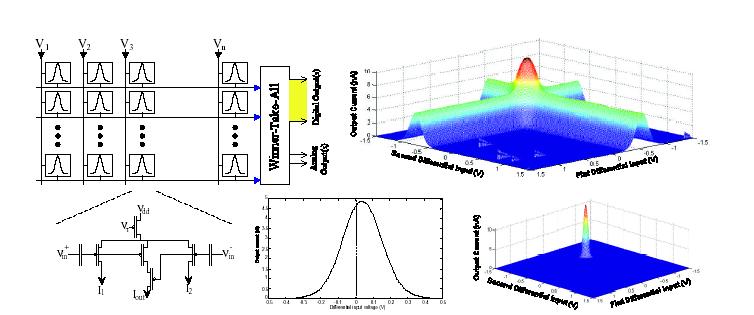

Floating-gate circuits start from floating-gate MOS transistors, typically built in a standard CMOS process. The primary principle is the polysilicon gate of a MOS transistor completely wrapped in silicon dioxide maintaining stored charge for a long period of time. Since the first report of floating-gate devices in 1967 [3], digital floating-gate circuits have merged to a mature technology present in every personal computer in the form of EPROMs, EEPROMs, and flash memories[4]. More recently, an increasing number of applications have been published uncovering new and exciting ways of using floating-gate devices and circuits [5][6][7][8][9][10], as well as audio recording products based upon analog floating-gate memories [11]. Since the floating-gate devices are MOS transistors, they are analog circuit elements and can be used as programmable and adaptable circuit elements with nonvolitile analog memory. We have leverage the programmablity and adaptability of this technology to allow for simultaneous storage, computation, and programming in one or two single-transistor EEPROM cells [12][13][14].
Because a floating gate is a polysilicon gate surrounded by silicon-dioxide, charge on the floating gate is stored permanently, providing a long-term memory. Furthermore, the charge on this floating-gate can be modified by projecting UV light on the chip, by applying large voltages across a silicon-oxide capacitor to tunnel electrons though the oxide, or by adding electrons using hot-electron injection [8][10]. Since a large number of electrons can be stored on an integrated capacitor, we can store a nearly continuous analog voltage allowing the creation of long-term, non-circuit volatile information storage devices for analog applications. Floating-gate circuits have the inherent ability to adapt to the incoming and outgoing signals by continuously enabling these programming mechanisms. This property was the fundamental motivation behind the development of single-transistor synapses, single floating-gate FETs that emulate some of the computational and adaptive properties of biological synaptic elements [10]. These elements enable floating-gate currents to be modulated in a continuous fashion (using complementary electron tunneling and hot-electron injection processes) without significantly altering the circuit's behavior.

The core cell is built from a floating-gate bump circuit, which allows the target mean value to be stored and subtracted from the broadcasted input signal. We see that output current (experimental measurements) of the middle leg of the bump circuit reaches a maximum at its center value, and falls o exponentially as one moves from that center value. This output current is summed together with the output from other bump circuits. We also show experimental data when sweeping two inputs to see the multidimensional structure of the bump function. We get a region of high response where both bumps occur, and far away from the center, the response is nearly invarient with input voltage. Near the center of a bump in one dimension, but away from the center of the bump in the second dimension, we still see a significant response. To get an ideal VQ type bump, we would want to assume that our output is a log-encoded version of the actual output. We also show a nearly exponential expanded result using a power of 10 circuit, which is fairly easy to perform using translinear techniques (most on-chip techniques for taking the exponential of a current effectively result in a large power law). Experimental results measured from ICs fabricated on a 0.5um CMOS process available through MOSIS.
Figure 1 shows the floating-gate based system for computing vector quantization (VQ) [1]. An analog implementation of VQ is a more computationally efficient approach than the equivalent digital VQ implementation. One can either choose to compute at higher input signal frequencies at the same power consumption, compute at the same input signal frequencies at a much lower power consumption, or a combination of these approaches. We see this technology as a fundamental component in a low-power speech recognition system [17], as well as in other sensory processing applications.
back to Key Technologies